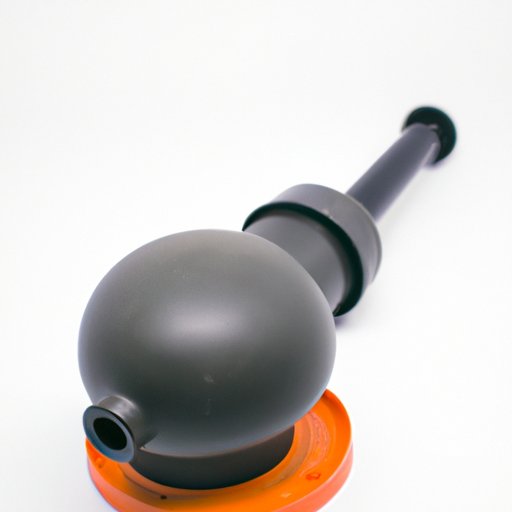Introduction
A plunger is an essential tool for any homeowner’s toolbox. But what is a plunger? And why understanding how a plunger works can be helpful? A plunger is a handheld device used to clear blockages in drains, toilets, and other plumbing fixtures. By understanding the mechanics of a plunger, you will be able to identify the type of plunger needed to clear any clog and use it correctly.
Exploring The Mechanics of the Plunger: How Does It Work?
The first step in understanding how a plunger works is to define it. A plunger is a simple device made up of two parts: a handle and a cup. The handle is usually made of wood or plastic, while the cup is typically made of rubber. The cup is designed to form a seal over the opening of the drain or toilet.
Next, let’s look at the anatomy of a plunger. The cup is the main part of the plunger and is shaped like a bell. The cup has a lip that is designed to fit snugly around the drain or toilet opening. This allows the plunger to create a tight seal when it is pressed against the opening.
There are different types of plungers and each one serves a specific purpose. The most common types of plungers are the cup plunger and the flange plunger. The cup plunger is best used for unclogging sinks and bathtubs, while the flange plunger is better suited for unclogging toilets.
Understanding the Basics of a Plunger: What Makes It Tick?
Now that we have explored the anatomy of a plunger, let’s take a look at how it works. When the plunger is pressed against the opening of the drain or toilet, it creates a vacuum. This vacuum forces air out of the area, causing the pressure inside the drain or toilet to drop.
The pressure inside the drain or toilet is lower than the pressure outside, which causes the water to be drawn into the drain or toilet. This creates suction, which helps to loosen and remove the clog. The suction also helps to force air through the clog, pushing it out of the drain or toilet.
In addition to suction, a plunger also uses air pressure to clear clogs. As the plunger is pulled away from the drain or toilet, air is forced back into the area. This causes the pressure inside the drain or toilet to increase, pushing the clog out of the drain or toilet.
A Guide to Plungers: An In-Depth Look at Their Functionality
Once you understand the basics of how a plunger works, it’s time to learn how to use it. Different types of plungers are used for different types of clogs. For example, a cup plunger is best used for clogs in sinks and bathtubs, while a flange plunger is better suited for clogs in toilets.
When using a plunger, it’s important to make sure it is pressed firmly against the drain or toilet opening. This will ensure a tight seal, allowing the plunger to create a strong suction. You should also make sure to use enough force when pulling the plunger away from the opening. This will help to push the clog out of the drain or toilet.
Finally, there are a few tips to keep in mind when using a plunger. First, make sure to fill the sink or tub with enough water to cover the plunger cup before plunging. This will help to create a stronger suction. Second, don’t use too much force when plunging, as this could damage the pipes. Finally, if the clog isn’t cleared after several attempts, it’s best to call a professional plumber.
From Clogs to Clarity: Uncovering the Power of a Plunger
Clogs in drains and toilets can be caused by a variety of things, such as hair, grease, food, and soap scum. Fortunately, a plunger can help to clear most clogs. By creating a vacuum and using air pressure, a plunger can help to loosen and remove the clog from the drain or toilet.

Breaking Down the Science Behind Plungers: Discovering How They Work
At its core, a plunger works by creating a vacuum and using air pressure. When the plunger is pressed against the opening of the drain or toilet, it creates a vacuum. This vacuum forces air out of the area, causing the pressure inside the drain or toilet to drop. The pressure inside the drain or toilet is lower than the pressure outside, which causes the water to be drawn into the drain or toilet. This creates suction, which helps to loosen and remove the clog. The suction also helps to force air through the clog, pushing it out of the drain or toilet.
When the plunger is pulled away from the opening, air is forced back into the area. This causes the pressure inside the drain or toilet to increase, pushing the clog out of the drain or toilet. By understanding the science behind a plunger, you can use it effectively to clear clogs in drains and toilets.
Conclusion
A plunger is a simple yet powerful tool for clearing clogs in drains and toilets. By understanding the mechanics of a plunger, you can identify the type of plunger needed to clear any clog and use it correctly. A plunger works by creating a vacuum and using air pressure to loosen and remove the clog. With a little bit of practice, you can use a plunger to solve even the toughest clogs with ease.
(Note: Is this article not meeting your expectations? Do you have knowledge or insights to share? Unlock new opportunities and expand your reach by joining our authors team. Click Registration to join us and share your expertise with our readers.)
